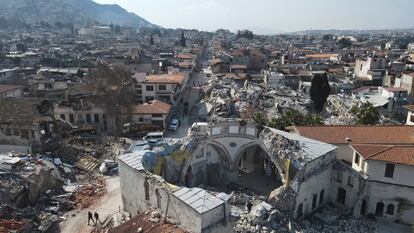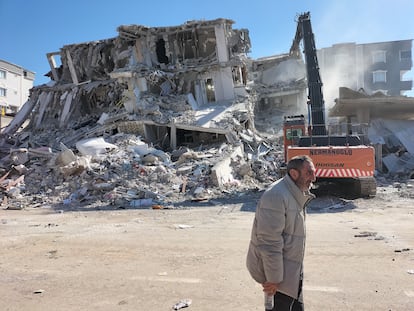Turkey arrests building contractors six days after quakes
Turkish officials have detained or issued arrest warrants for some 130 people allegedly involved in the construction of buildings that toppled down and crushed their occupants

As rescuers still pulled a lucky few from the rubble six days after a pair of earthquakes devastated southeast Turkey and northern Syria, Turkish officials detained or issued arrest warrants for some 130 people allegedly involved in the construction of buildings that toppled down and crushed their occupants.
The death toll from Monday’s quakes stood at 28,191 – with another 80,000-plus injured – as of Sunday morning and was certain to rise as bodies kept emerging.
As despair also bred rage at the agonizingly slow rescue efforts, the focus turned to who was to blame for not better preparing people in the earthquake-prone region that includes an area of Syria that was already suffering from years of civil war.
Even though Turkey has, on paper, construction codes that meet current earthquake-engineering standards, they are too rarely enforced, explaining why thousands of buildings slumped onto their side or pancaked downward onto residents.
Turkish Vice President Fuat Oktay said late on Saturday that warrants have been issued for the detention of 131 people suspected to being responsible for collapsed buildings.
Turkey’s justice minister has vowed to punish anyone responsible, and prosecutors have begun gathering samples of buildings for evidence on materials used in constructions. The quakes were powerful, but victims, experts and people across Turkey are blaming bad construction for multiplying the devastation.
Authorities arrested two people in the province of Gaziantep on Sunday who are suspected of having cut down columns to make extra room in a building that collapsed, the state-run Anadolu Agency said.
A day earlier, Turkey’s Justice Ministry announced the planned establishment of “Earthquake Crimes Investigation” bureaus. The bureaus would aim to identify contractors and others responsible for building works, gather evidence, instruct experts including architects, geologists and engineers, and check building permits and occupation permits.
A building contractor was detained by authorities on Friday at Istanbul airport before he could board a flight out of the country. He was the contractor of a luxury 12-story building in the historic city of Antakya, in Hatay province, the collapse of which left an untold number of dead.
The detentions could help direct public anger toward builders and contractors, deflecting attention away from local and state officials who allowed the apparently sub-standard constructions to go ahead. Turkish President Recep Tayyip Erdoğan’s government, already burdened by an economic downturn and high inflation, faces parliamentary and presidential elections in May.
Survivors, many of whom lost loved ones, have turned their frustration and anger also at authorities. Rescue crews have been overwhelmed by the widespread damage which has impacted roads and airports, making it even more difficult to race against the clock.
Erdogan acknowledged earlier in the week that the initial response has been hampered by the extensive damage. He said the worst-affected area was 500 kilometers (310 miles) in diameter and was home to 13.5 million people in Turkey. During a tour of quake-damaged cities Saturday, Erdoğan said a disaster of this scope was rare, and again referred to it as the “disaster of the century.”
Rescuers, including crews from other countries, continued to probe the rubble in hope of finding additional survivors who could yet beat the increasingly long odds. Thermal cameras were used to probe the piles of concrete and metal, while rescuers demanded silence so that they could hear the voices of the trapped.
A 6-year-old boy was removed from the debris of his home in Adiyaman city on Sunday, 151 hours after the quake. The rescue was broadcast live by HaberTurk television, showing the child wrapped in a space blanket and put into an ambulance. An exhausted rescuer removed his surgical mask and took deep breaths as a group of women could be heard crying in joy.
Turkey’s health minister, Fahrettin Koca, posted a video of a young girl in a navy blue jumper who was rescued. “Good news at the 150th hour. Rescued a little while ago by crews. There is always hope!” he tweeted.
The efforts of a team of Italian and Turkish rescuers also paid off when they removed a 35-year-old man from the wreckage in the hard-hit city of Antakya. The man, Mustafa Sarigul, appeared to be unscathed as he was being transported on a stretcher to an ambulance, 149 hours after the first quakes, private NTV television reported.
Overnight, a child was also freed in the town of Nizip, in Gaziantep, state-run Anadolu Agency reported, while a 32-year woman, was rescued from the ruins of a eight-story building in the city of Antakya. The woman, a teacher named Meltem, asked for tea as soon as she emerged, according to NTV.
In Kahramanmaras, near the epicenter of the first 7.8 quake that struck early Monday morning, efforts were underway to reach a survivor detected by sniffer dogs beneath a now-pancaked seven-story building, NTV reported.
Those found alive, however, remained the rare exception.
A large makeshift graveyard was under construction in Antakya’s outskirts on Saturday. Backhoes and bulldozers dug pits in the field as trucks and ambulances loaded with black body bags arrived continuously. The hundreds of graves, spaced no more than 3 feet (a meter) apart, were marked with simple wooden planks set vertically in the ground.
The picture is less clear of the plight across the border in Syria.
The death toll in Syria’s northwestern rebel-held region has reached 2,166, according to the rescue worker group the White Helmets. The overall death toll in Syria stood at 3,553 on Saturday, though the 1,387 deaths reported for government-held parts of the country hadn’t been updated in days.
Sign up for our weekly newsletter to get more English-language news coverage from EL PAÍS USA Edition
Tu suscripción se está usando en otro dispositivo
¿Quieres añadir otro usuario a tu suscripción?
Si continúas leyendo en este dispositivo, no se podrá leer en el otro.
FlechaTu suscripción se está usando en otro dispositivo y solo puedes acceder a EL PAÍS desde un dispositivo a la vez.
Si quieres compartir tu cuenta, cambia tu suscripción a la modalidad Premium, así podrás añadir otro usuario. Cada uno accederá con su propia cuenta de email, lo que os permitirá personalizar vuestra experiencia en EL PAÍS.
¿Tienes una suscripción de empresa? Accede aquí para contratar más cuentas.
En el caso de no saber quién está usando tu cuenta, te recomendamos cambiar tu contraseña aquí.
Si decides continuar compartiendo tu cuenta, este mensaje se mostrará en tu dispositivo y en el de la otra persona que está usando tu cuenta de forma indefinida, afectando a tu experiencia de lectura. Puedes consultar aquí los términos y condiciones de la suscripción digital.
More information
Fear and miracles at the center of the earthquake’s devastation
Últimas noticias
The complicated life of Francesca Albanese: A rising figure in Italy but barred from every bank by Trump’s sanctions
Half of Scotland is in the hands of 420 property owners
Pinochet’s victims grapple with José Antonio Kast’s rise in Chile
Reinhard Genzel, Nobel laureate in physics: ‘One-minute videos will never give you the truth’
Most viewed
- Pablo Escobar’s hippos: A serious environmental problem, 40 years on
- Reinhard Genzel, Nobel laureate in physics: ‘One-minute videos will never give you the truth’
- Why we lost the habit of sleeping in two segments and how that changed our sense of time
- Charles Dubouloz, mountaineering star, retires at 36 with a farewell tour inspired by Walter Bonatti
- The Florida Keys tourist paradise is besieged by immigration agents: ‘We’ve never seen anything like this’









































